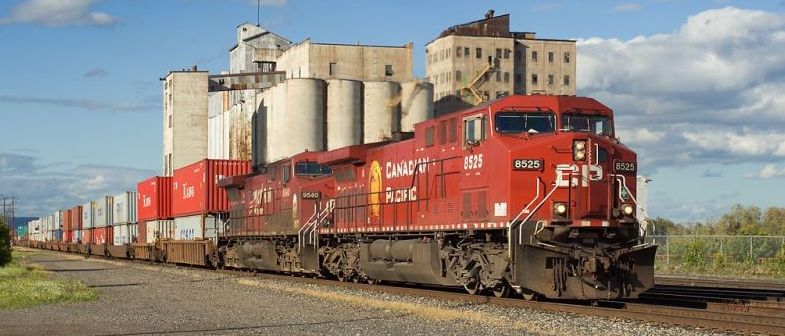
Train Addiction Help Line: 1.866.840.7777
Mar 4, 2021 - HO Scale
NARC - HO Scale - NSC 5431cuft 3 Bay Hopper - New information & New 3D Images! - UPDATE

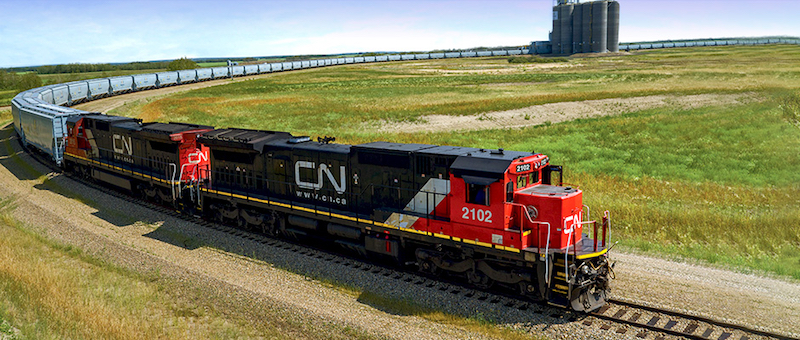
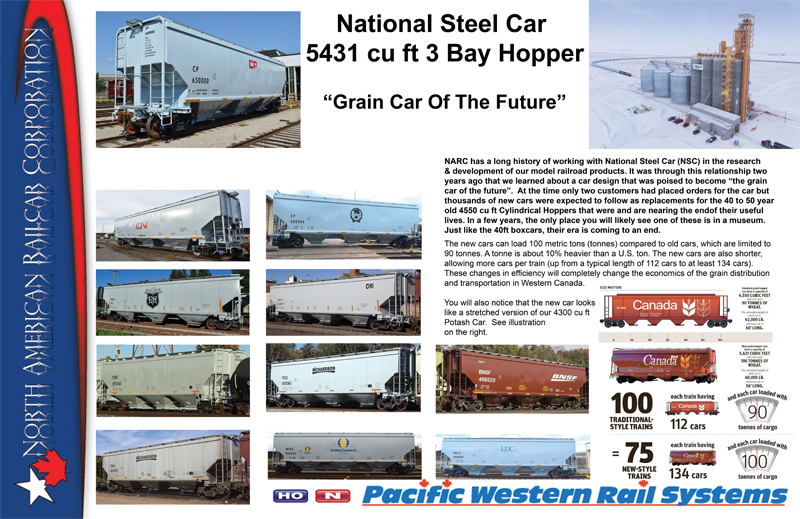
- UPDATE -
CN and Hopper Car Fleet Innovation
CN has a multi-pronged approach to the hopper car fleet for bulk grain – with fits for customers small and large
CN’s approach to fleet composition for the movement of bulk grain has fundamentally changed over the past five years. What was once a fleet dominated by leased and owned CN-supplied hoppers is now much more diverse. It includes customer-supplied high capacity hoppers integrated into CN’s common pool, brand new CN hopper cars, and high capacity, customer-controlled private cars. It doesn’t matter to a producer whether it’s a CN or a private hopper or hopper being spotted at an elevator – those hoppers are making space for more grain to be delivered – and a tonne delivered is a tonne paid for.
Steady Growth in the Car Spotting Program in Western Canada
CN’s 2020-21 Grain Plan included guidance on CN’s maximum sustainable supply chain capacity for bulk grain movement for CN-supplied hoppers - 5,800 hoppers per week outside of winter and 4,500 per week in winter. If we are able to deliver more, we will. And the size of the spotting program that CN delivers on a weekly basis has kept up with the percentage increase in the size of western Canadian grain production.
Private hoppers moving bulk grain are in addition to CN-supplied hoppers. What was once 10 or 20 private cars per week has increased to 1000+ cars per week at times. CN’s maximum sustainable supply chain capacity for bulk grain movement for customer-controlled private hoppers for 2020-21 is 950 cars per week outside of winter and over 750 cars per week during winter. The shift to private cars – in corridors where it is operationally efficient to do so - is a fundamental change in how customers can secure car supply to move grain on CN in western Canada. And a large segment of this car supply is comprised of new generation, high capacity cars.
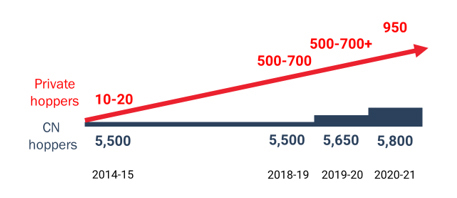 |
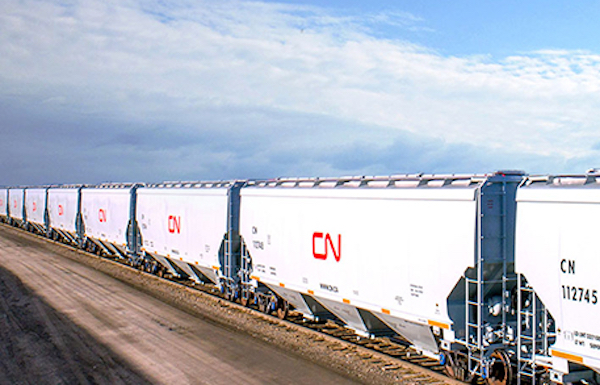 |
CN Commercial Car Supply Agreements
For most grain movement in western Canada, customers place orders for CN-supplied hoppers, and most of these orders are tied to commercial car supply programs. A portion of the CN pool is made up of customer-supplied jumbo hopper cars that CN integrates into its common pool. The customer receives priority car supply based on the total number of cars supplied and the cycle time associated with the lanes those cars are moving in. Besides ensuring priority car supply, especially in times when demand for hopper cars tends to exceed end-to-end supply chain capacity, this program is inclusive – minimum 25-car block shipments – allowing smaller players to secure car supply. Participants don’t need to own country elevators to participate. Car supply is tradable in the market and CN and the customer each have commercial, reciprocal obligations. It is a win-win approach that has grown in popularity since it was first introduced in the 2014-15 crop year.
The Next Generation of High Efficiency Hopper Cars
In August 2018, CN announced the acquisition of 1,000 high capacity, new generation hopper cars to be built at National Steel Car in Hamilton, ON. These 55 foot, 8 inch long hoppers have a capacity of 5,431 cubic feet, compared to today’s standard jumbo hopper car at 5,150 cubic feet and 58+ feet. In late July 2020, CN announced the acquisition of another 1,500 new high-capacity hopper cars for delivery during the 2020-21 crop year. CN will start taking delivery of these cars this fall and will have most of them delivered by early 2021.
Higher capacity means more tonnes of lighter loading commodities like canola, barley, and oats can be loaded in these cars before they cube out, so more tonnage moved with every car spot. And don’t forget these cars are shorter as well, so more cars can fit into the same amount of track capacity. It all adds up to more capacity to move more grain, especially when it wants to move the most after harvest into early spring.
For the 2020-21 crop year, CN will run a number of sets of these new high capacity cars as truly dedicated train sets committed to customers and continuously cycling during the crop year. Customers can expect to receive the same set of cars back for the next load for every trip.
Looking Ahead
CN’s innovative approaches to hopper car fleet supply and management have translated into stronger grain movement, and contributed to CN’s record grain volume in the 2019-20 crop year. Over the past four crop years, thanks to the wide variety of fleet solutions that customers are able to utilize, average tonnage shipped per car on CN out of western Canada has increased by over three metric tonnes, or over three per cent. Moving more tonnage per car means moving more tonnage during peak hopper car demand. That means more grain getting delivered to country elevators. Customers have multiple commercial tools that they can utilize with CN to secure priority car supply and cover their shipping requirements. The future is bright for the end-to-end grain supply chain on CN.
Canadian Pacific puts biggest grain train on rails to B.C
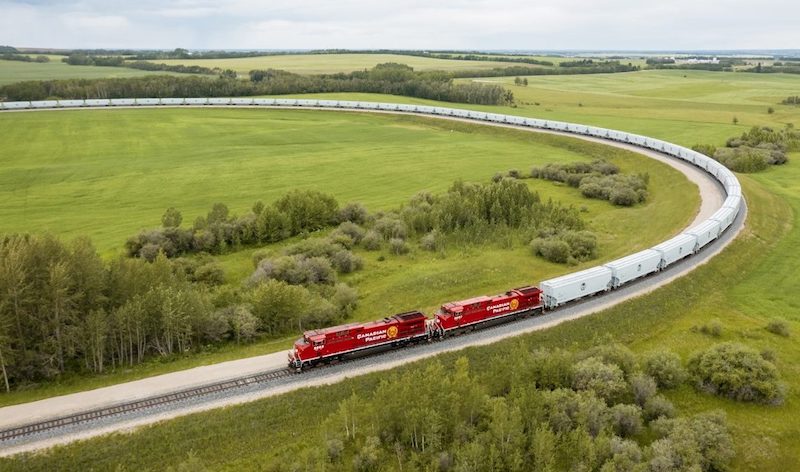
CP's Largest Ever Grain Train (CREDIT: Paterson Grain)
Paterson Grain announced earlier this month the shipment of Canadian Pacific's largest ever grain train moved from Paterson's terminal in Bowden, Alberta, to Vancouver, British Columbia.
The train, consisting of 167 new high-capacity hopper cars, was loaded at the company's Foothills Terminal and transported 16,313 metric tons of grain to the Alliance Grain Terminal in Vancouver, Paterson officials said in a press release.
Paterson loaded the train in less than 14 hours and took less than four days to reach the terminal in Vancouver.
"Our new third generation grain terminals are amongst the most efficient grain facilities in the world today," said Paterson President and Chief Executive Officer Andrew Paterson. "From the producer to the supplier to the end-use consumer, our system can ship grain to exceed expectations."
CP President and CEO Keith Creel also recognized the agri-food company's milestone.
"We applaud Paterson's continued efforts to lead progressively to new levels of production capacity in the grain supply chain," Creel said.
New information on the National Steel Car’s 5431 cubic-foot 3-bay through-sill covered hopper & New 3D Images - Check It Out!
Once again North American Railcar Corporation has pushed the envelope with their replica HO and N scale models of National Steel Car’s 5431 cubic-foot 3-bay through-sill covered hopper. Not only have we faithfully reproduced the details, we’ve faithfully reproduced the details on nine different versions!
Let’s start off with one basic body with 11 welded side panels, but there’s also two different bolster/jackpads (NSC-style and a square one reminisent of Trinity’s bolsters), two different roofs (11 and 16 running board supports), two different trough hatches (rounded and square ends), two different end frames (tapered or beveled top corners), two different hopper bays (with or without vibrator brackets), three different outlet gates (ATP short and Miner long gravity and ATP gravity/pneumatic), plus, we have even tooled up a brand new, super detailed, smooth running 100-ton ASF Motion Control trucks with 36” scale wheels with 0.88” semi-scale tread to ride under this ultra-modern grain car. These are the correct “sway-back” trucks that are standard for these cars. Real Kadee number 148 semi-scale whisker couplers in semi-scale, detailed coupler boxes complete this super-detailed replica.
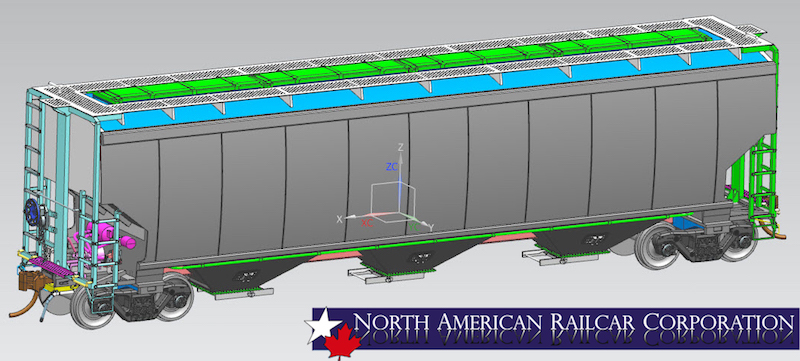
NARCorp “Version 1”, with 11 running board supports, squared trough hatches, type 1 (tapered top corner)
end frames, type 1 bolster/jack pad and ATP long gate frame outlet gates.
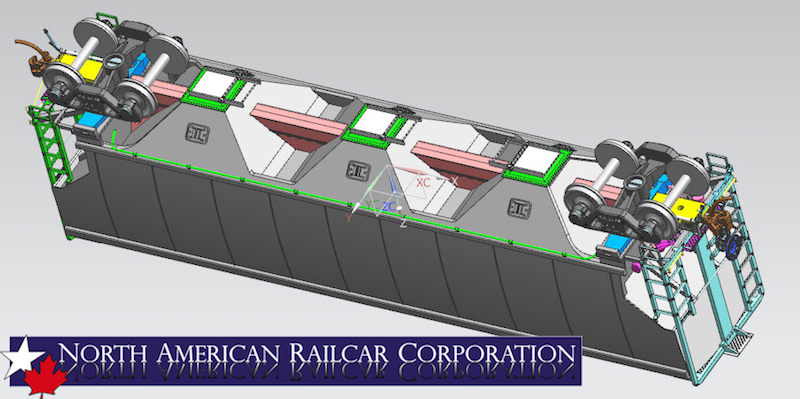
The underbody detail on the new NARCorp NSC 5431 scale model closely matches the real cars, right down to the correct number of rivets on the super-detailed outlet gates1 This view shows the “through-sill” design of these covered hoppers. We’ve also made the coupler pockets to semi-scale dimensions so that the coupler pockets don’t detract from the overall fine lines of these cars.
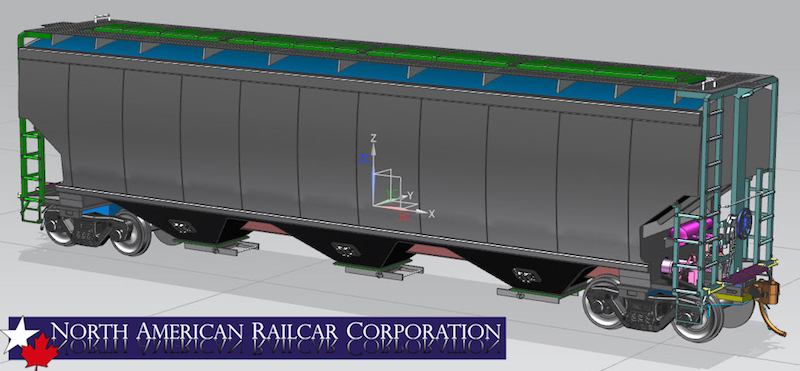
Classic roster view of the all new-NSC 5431 – Version 1 of 9!
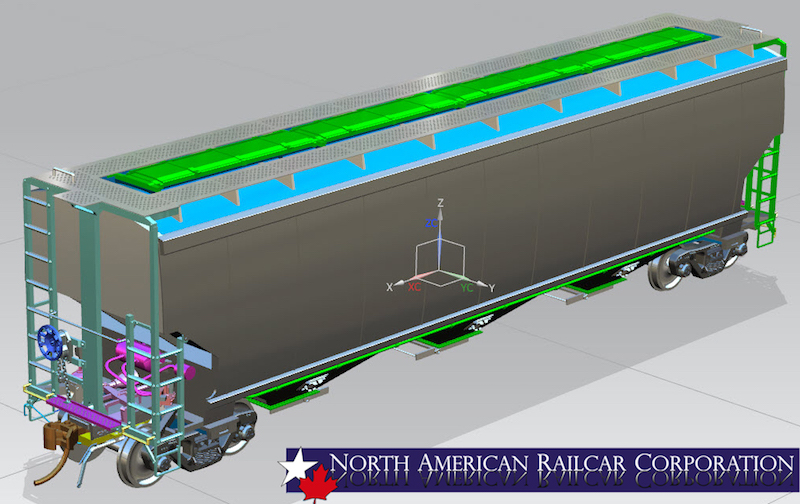
Etched metal running boards, end crossover platforms and bent wire grabs are just some of the fine detail
included on the all new NARCorp NSC 5431 3-bay covered hopper fine scale replica models.
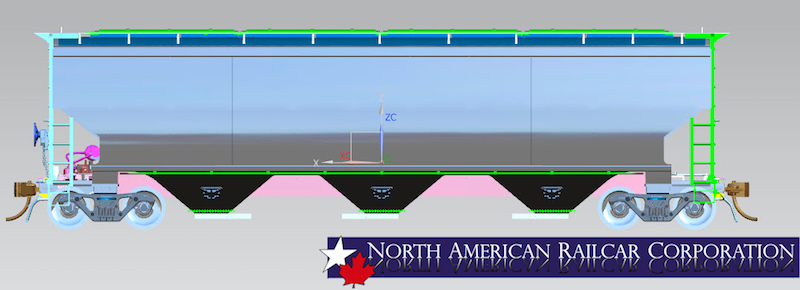
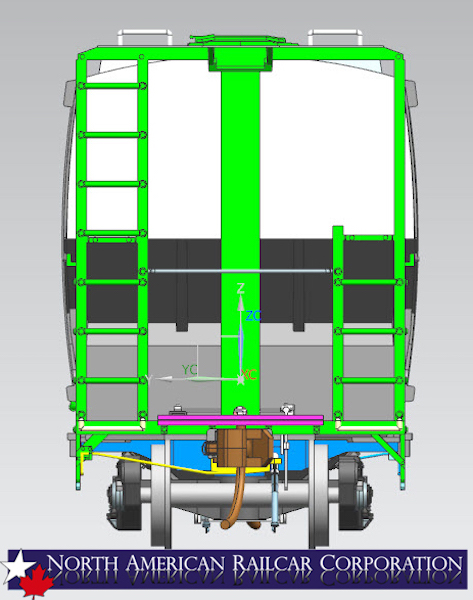
A-end view of version 1 of 9 of the NSC 5431 3-bay covered hopper. This is the “type 1” end frame,
with the tapered top corners of the frame.
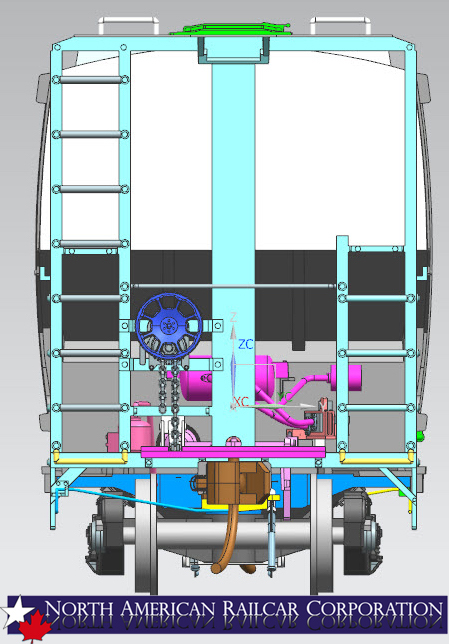
The B-end has a super-detailed Universal hand brake and wheel, brake reservoir and related plumbing, plus bent wire grabs and coupler cut bar.
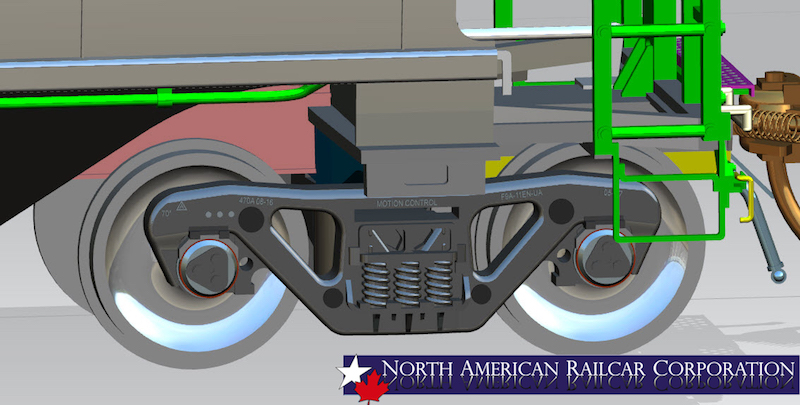
Brand new smooth running 100-ton ASF Motion Control trucks with
“sway back” side frames to match the prototype.
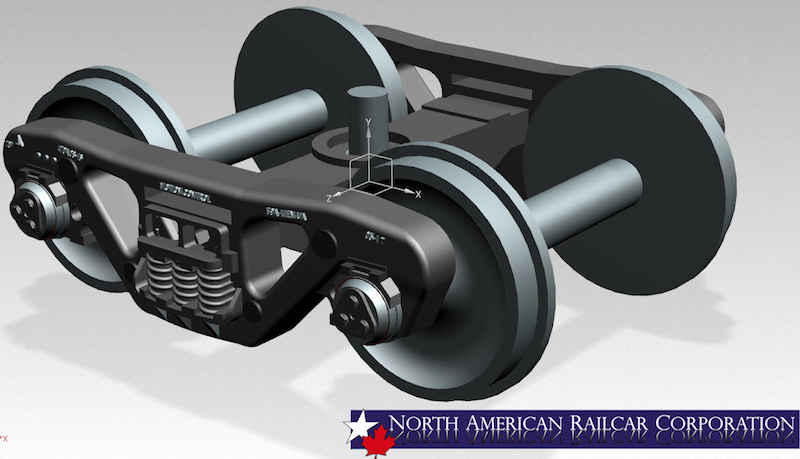
Our brand new 100-ton ASF Motion Control trucks feature smooth running 36” scale wheels
with standard 0.88” tread and even include legible foundry casting markings!
Stay tuned for more information on these
modern-era grain cars!
Coming soon to a web site near you…
CP sets new monthly record for transporting grain.
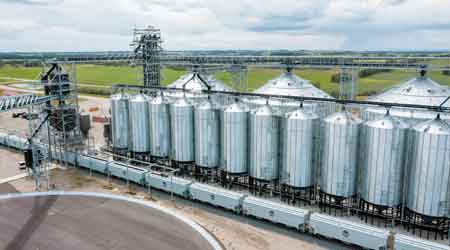
In July, Paterson Grain’s Foothills Terminal in Bowden loaded the first Alberta-originated 8,500-foot high efficiency product train featuring CP’s new hopper cars.
Photo – Canadian Pacific
Canadian Pacific last month broke another record for moving Canadian grain and grain products.
The Class I delivered 2.74 million metric tons (MMT) during November, beating the October 2019 all-time record of 2.66 MMT, CP officials said in a press release.
In addition to setting a new record, the railroad marked two other milestones last month:
• More CP carloads of grain were unloaded at the Port of Thunder Bay during the week of Nov. 18-24 than in any prior week. CP customers' terminals in Thunder Bay unloaded a record 2,216 cars during that week, surpassing the previous weekly record of 2,144 in fall 2017.
• On Nov. 22, CP held an Alberta Agriculture Round Table event to discuss capacity gains in the grain supply chain, featuring CP's new 8,500-foot high-efficiency product (HEP) train model. Attendees included agricultural industry officials, senior government leaders and representatives of CP's operations, sales and marketing teams.
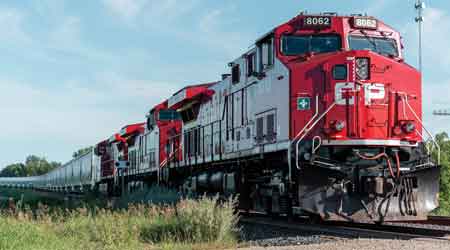 |
|
|
Through 2019’s first nine months, CP’s grain carloads slipped 1 percent to 312,500 units,
but revenue rose 9 percent to CA$1.2 billion on a year-over-year basis.
Canadian Pacific
|
"The CP team will keep open the lines of communication with shippers and government leaders as we push to become even more effective and efficient to meet the growing needs of Canada's agricultural sector," said Joan Hardy, CP's vice president of sales and marketing, grain and fertilizers.
Canadian Pacific targets longer grain trains, another banner crop year
By Jeff Stagl, Managing Editor
For Canadian Pacific, grain is a vital business-boosting commodity. Loads of corn, soybeans, wheat, canola, specialty crops and other grains generate about one-fourth of annual revenue.
“Grain is our largest line of business,” wrote CP President and Chief Executive Officer Keith Creel in the Class I’s 2019-20 grain service outlook that was submitted July 31 to the Canadian government.
The Class I has moved substantial amounts of the agricultural products in Canada for more than a century.
“Moving grain is in our DNA,” Creel wrote. “We are proud of this rich history and excited for the future.”
There are several reasons why CPers believe the railroad remains well positioned to serve and exploit that ag market. For one, CP is the only Class I with significant grain franchises in both Canada and the United States.
Its network is strategically positioned through the heart of major farming regions in western Canada and the U.S. Northern Plains, company leaders say. The stateside portion has been in place since 2008, when CP acquired the Dakota, Minnesota & Eastern Railroad and its farm-rich lines in Iowa, Illinois, Minnesota, Nebraska, South Dakota and Wyoming.
CP currently serves 342 elevators — 175 in the United States and 167 in Canada — that ship grain to major ports for export. As more elevator capacity is added each year, the railroad’s grain origination footprint continues to expand. Currently, nine new high-throughput elevators are under construction and more than 40 elevators are planning expansions in its network.
The railroad already is the top transportation provider for Canada’s growing oilseed processing industry, serving 12 major crush facilities with 9 million metric tons (MMT) of capacity. It taps another 2 MMT of canola crush capacity in North Dakota and Minnesota, as well as several soybean crush plants in Iowa.
To ensure grain remains a be-all, end-all business-boosting enterprise, the Class I has strived to build strong relationships with producers and the Canadian government. The railroad also has worked to establish and refine the necessary capacity, resources, disciplined operating plan — namely precision scheduled railroading — and product innovations to keep grain flowing through its system, CP leaders say.
A lot of grain was on the move through 2019’s first nine months, albeit at just a slightly lower clip than last year. Grain carloads slipped 1 percent to 312,500 units, but revenue climbed 9 percent to CA$1.2 billion compared with totals from 2018’s first nine months. In the third quarter, revenue rose 7 percent to CA$409 million while carloads dipped 1 percent to 106,600 units.
CP’s Canadian grain and grain products volume was especially strong during the 2018-19 crop year (Aug. 1, 2018 to July 31, 2019), when the railroad moved a record 26.8 MMT. For the first time, the Class I transported 15,000-plus carloads of western Canadian grain and grain products to the Port of Vancouver for three straight months (September to November 2018) in a single crop year. In addition, the Class I set an April volume record at 2.64 MMT and established a May high for grain products tonnage and carloads, not including whole grains.
CP leaders hailed the 2018-19 crop year as a largely successful one in a press release issued Aug. 1.
“[We] work closely with customers to bring North American commodities to market safely, reliably and efficiently,” said Joan Hardy, CP’s vice president of sales and marketing-grain and fertilizers. “Tight coordination across the supply chain enables maximum efficiency even during challenging winter months.”
Weather delays
However, the 2019-20 crop year got off to a tough start with some unexpected headwinds well before any snowflakes began to fall. In August and September, trade tensions with China continued to negatively impact the Class I’s U.S. grain business while wet and cool weather in the prairies wreaked havoc with the Canadian harvest.
In September, the harvest fell 20 percent to 30 percent behind schedule. As a result, the Class I moved about 1,000 fewer carloads per week during the month than in prior years.
The harvest delay will pressure the railroad to move more grain later in the crop year to meet demand and volume obligations. The good news: Traffic began to accelerate in October due to drier weather.
“Volumes have begun to pick up and we are confident that any volumes not moved this fall will move in 2020,” said CP Executive Vice President and Chief Marketing Officer John Brooks during the Class I’s Q3 earnings conference on Oct. 23.
The harvest delay was more of a timing issue than a reflection of the grain market’s strength, Creel said Sept. 11 at Morgan Stanley’s annual conference in Dana Point, California.
“It doesn’t mean the grains are not going to move,” he said. “The encouraging part … is actually the quality of the grain is high, the yields are high.”
Brooks concurs.
“We view these bulk headwinds largely as episodic. Looking ahead, the fundamentals for grain and potash and coal look good,” he said during the conference. “The crop size looks similar to last year and we continue to watch closely the impacts of quality, resulting from this late harvest.”
CP expects another strong harvest in crop-year 2019-20, with western Canadian grain production estimated to reach 71 MMT to 72 MMT. The railroad has the capacity to move 31.2 MMT of grain and grain products during the crop year, but since typical demand seasonality tends to cause softness in late spring and summer, its 2019-20 volume target is 27 MMT to 28 MMT.
Longer, heavier and wider
To realize that tonnage, the Class I plans to continue increasing train lengths and weights, and adding resources. For the crop year, CP is targeting 1,100 to 1,150 locomotives in service, up to 15,700 hopper cars, and 4,350 to 4,420 train and engine employees to help move an average of 1,050 cars of grain products per week.
CP continues to add workers and locomotives to meet customers’ demands. Since 2016, the workforce has widened by 12 percent, including more than 700 new employees in 2018.
The railroad also is undertaking what company leaders characterize as a “robust” locomotive modernization program that so far has involved more than 130 units in the fleet. A total of 170 locomotives are slated to be modernized by 2019’s end.
In terms of average train length and weight, both have increased significantly over the past five years, From 2014 through 2018, train length grew 13 percent from 6,682 feet to 7,313 feet while train weight climbed 9 percent from 8,076 tons to 9,100 tons. CP leaders say the railroad is positioned to further increase average train length and weight — as well as boost train speed and reduce dwell time to aid grain movements — since longer, heavier and faster trains help increase network capacity and reduce operating costs.
Capital investments in 2019 figure to help support grain movements, as well. By year’s end, CP expected to complete the following in Alberta: extend double track in Stephen; build a 9,600-foot siding in Metiskow; extend a 7,200-foot siding to 12,000 feet in Penhold; extend a 7,200-foot siding to 10,400 feet in Campaign; extend a 7,096-foot siding to 12,400 feet in Eldon; and extend two yards tracks to 8,800 feet at Calgary Terminal. Key projects in British Columbia set for a 2019 completion include a new 10,000-foot staging track in Sapperton and a track extension in Field.
Much of the capital work factors into what’s considered a game-changing product innovation for CP: a transition to an 8,500-foot high efficiency product (HEP) train model for grain. An 8,500-foot train can pull a minimum of 134 grain hoppers — based on industry-average car lengths — providing 20 percent more capacity than 112-car grain trains.
Introduced in summer 2018, the model calls for keeping a train’s composition intact with locomotives and hopper cars throughout the loading process. A customer uses CP’s locomotives to move a train through a loop track to facilitate grain car loading.
After a train is loaded, a CP crew moves it from the customer’s facility to the destination. All new elevators built on the Class I’s lines now need to incorporate either an 8,500-foot loop track or a continuous lead track to accommodate the HEP model.
Five elevators under construction will be ready for loading 8,500-foot trains this fall and four additional facilities will be poised to handle the longer trains by the end of the 2019-20 crop year, CP leaders project.
HEP model incentives
The Class I is working with customers to upgrade facilities to support the HEP model and add 8,500-foot loop track elevators at strategic locations. A recently implemented pricing framework offers grain shippers preferable freight rates if they transition to the model.
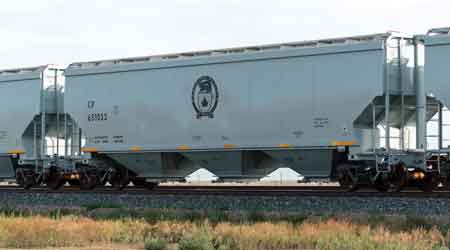 |
|
By employing longer trains and the new hopper cars, CP aims to carry 44
percent more tonnage on each grain unit train.
Canadian Pacific
|
The HEP model reduces loaded train dwell times, cycles trains faster and expands elevator capacity, CP leaders say. Coupled with a plan to acquire thousands of high-efficiency hoppers, the model also will significantly boost grain-moving capacity by about 44 percent, they add. Current 7,000-foot grain trains can carry 10,400 tons while 8,500-foot trains can transport 15,000 tons.
In June 2018, CP announced plans to spend more than $CA500 million to purchase 5,900 high-capacity grain hoppers from National Steel Car Ltd., over a four-year period. As of July 1, 1,278 of the new cars were in service; by year’s end, that number is expected to exceed 1,900. The new hoppers will enable CP to remove all low-capacity Canadian government cars from its fleet by 2022’s end.
The new cars are shorter and lighter than current hoppers, and feature a three-pocket design for more efficient loading and unloading compared with government-owned cars’ four pockets. The new hoppers can handle 15 percent more volume and 10 percent more load weight than the cars to be retired. In addition, the new cars will sport more reliable components that are designed to significantly reduce maintenance-related delays.
More cars, more grain
As the railroad and grain industry continue to adopt shorter, higher-capacity cars, the Class I will be able to fit more cars and more grain on each longer train, CP leaders say.
The railroad plans to eventually employ 147 of the high-capacity cars on 8,500-foot trains.
As the new cars “pay out” in additional capacity within the next few years, CP will be able to reduce annual capital spending from about $CA1.6 billion to $CA1.5 billion or less by 2021, Creel said at the Morgan Stanley conference.
The Class I also continues to offer a dedicated train program (DTP) to grain shippers to help spur more business. In place since the 2014-15 crop year, the program enables shippers to lock in dedicated capacity for a 12-month period, providing more visibility, predictability and control over their supply chain during a crop year, CP leaders say.
An important benefit of the DTP: Customers are incentivized to load and unload trains quickly, they add. The overall tonnage they can sell in the marketplace is a function of the overall cycle time of the dedicated capacity they have contracted, which drives increased grain movements.
Currently, 75 percent of customers’ shipments move in DTP capacity. Customers that choose not to participate in the DTP can order cars through an open distribution program, which was updated before the last crop year to cover two weeks of train demand.
CP in September presented its 2018-19 crop-year Elevator of the Year Award to G3 Ltd.’s Pasqua facility to recognize the shipper’s participation in the DTP as well as the HEP model. The railroad launched its first 8,500-foot train in December 2018 at the Pasqua elevator near Moose Jaw, Saskatchewan.
CP presents the award annually to an elevator that achieves high volumes from a single loading point, and consistently demonstrates efficient car loading and safety practices.
Negotiating the ups and downs
What the railroad is trying to demonstrate to shippers is that it’s built to take on more volume over the long term regardless of market peaks and valleys by leveraging its network strengths, reliable service and more efficient operations, Creel said during the Oct. 23 earnings conference.
“We are on track to be the only railroad with positive volume growth in 2019 … [as a] result of our disciplined approach to sustainable, profitable growth,” he said. “We see plenty of runway ahead.”
That includes more opportunities to build grain business. Unless, of course, “mother nature humbles us and brings us to our knees,” Creel said.
“We see an opportunity to move more freight, and obviously drive more earnings and drive more revenue growth,” he said
This is why we are doing this car.
New Videos and information regarding Richardson, Canadian National & Canadian Pacific
Many of you were wondering if the full length Richardson dedicated cars were legit.
The train Gods have answered your questions.
One of our customers in California recently ordered all of the Richardson 5431 hopper cars and told us that, full length Richardson dedicated trains are coming into California on Union Pacific. We were thrilled to hear this and asked our customer to take a photo the next time he saw them. Enjoy
photographed at JD Heiskell & Co elevator in Pixley, CA (An hour south of Fresno).
Now you know, full length Richardson Dedicated trains do exist.
Here's the proof! Order yours today.
Keep reading theres a lot more here!
New CN 5431 Hopper Photos: From Farm to Table
As required by the Government of Canada, Team CN has put in place a comprehensive, robust and focused action plan to meet the anticipated volume of grain expected to be moved in the crop year. The objective is clear. It is the effective, efficient and timely movement of grain throughout the coming crop year.
To develop its plan, CN collaborates with key stakeholders, including producers, seeking their views and input. The measures reflect extensive consultations with grain producers, grain-handling companies, customers and Government officials. The foundation for the measures is Agriculture and Agri-Food Canada’s projections for the crop year.
To Download your copy of the CN Grain Plan Click here

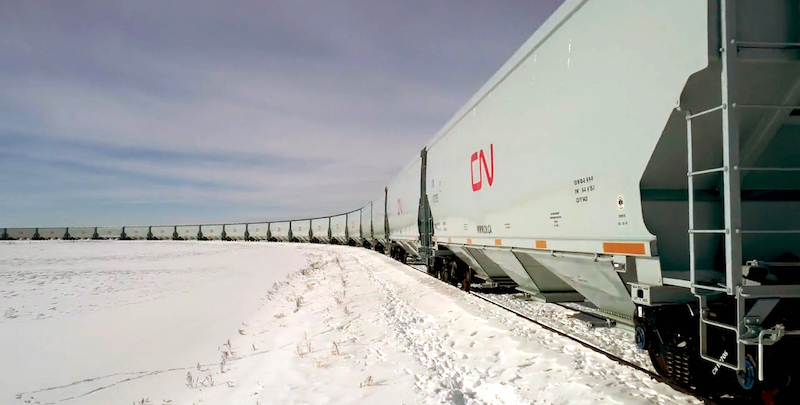
"The Thought of taking grain, oil seeds, pulses from western Canada, from my friend’s farms, shipping them onto a vessel and putting them onto somebody’s dinner plates on their table at home is really what got me engaged in agriculture." Dean McQueen VP- Merchandising and Transportation - Viterra
From Farm to Table: CN's New Hopper Fleet
New CP Photos: Greater supply chain & efficiency
The future of grain: greater supply chain capacity and efficiency
CP is driving towards a supply chain model capable of loading, transporting, and unloading 8,500-foot long, power-on, unit trains with a minimum of 134 hopper cars of export grain in Canada.
8,500 foot High Efficiency Trains (HEP)

The 8,500-foot train model will carry a minimum of 134 grain hopper cars based on industry-average car lengths, which is 20% more grain than 112 car grain trains. As CP and the industry move towards shorter, higher-capacity cars, CP will be able to fit more cars and more grain on each 8,500-foot train. The end result is more grain transported to market more efficiently than ever before.
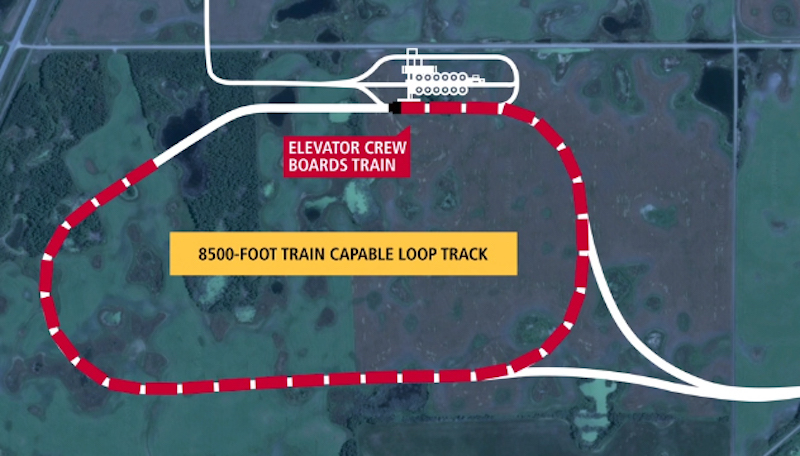
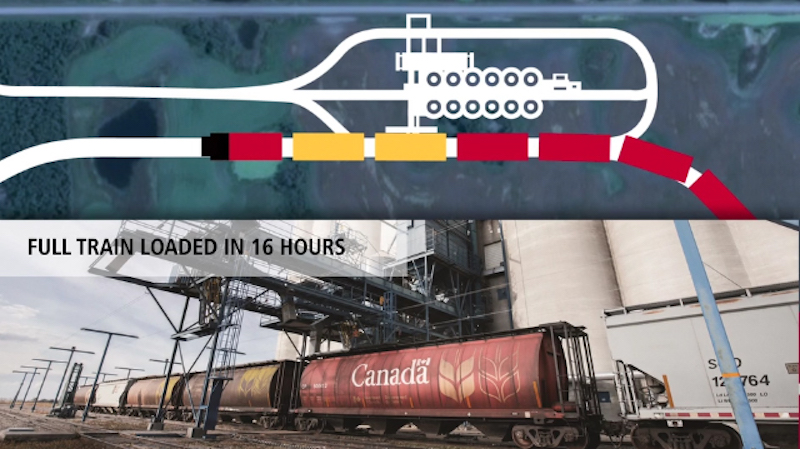
Check out video below!
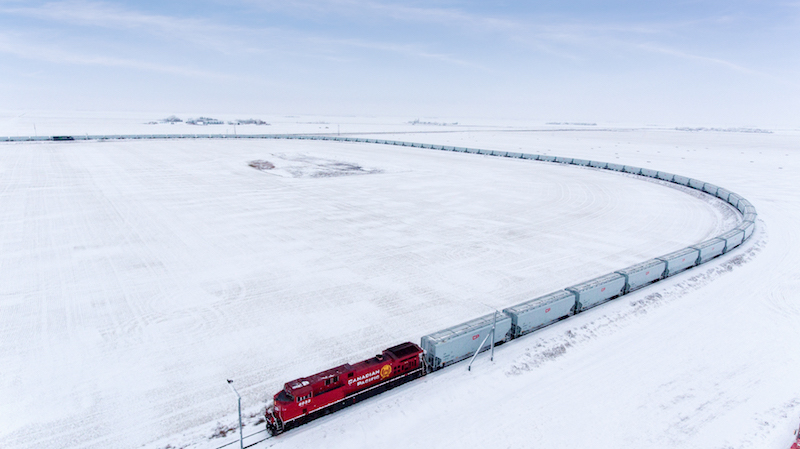
Grain elevator infrastructure
CP's investment in longer sidings and upgrades to its track network enable these longer trains to move seamlessly between elevators and ports. Elevators capable of receiving an intact 8500’ train to have the empty hoppers placed clear of our main track operations, loaded and made ready for pick up once again all clear for CP’s main track, providing the best use of capacity to move more grain.
Port terminal infrastructure
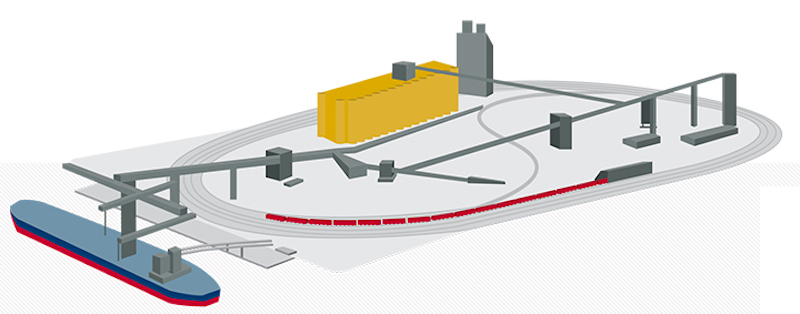
Through infrastructure investment and collaboration with grain companies and port operators, this enhanced train model allows railways, elevators, and ports to increase throughput and better utilize resources.
Grain elevator and port terminal infrastructure is being built and expanded to load and unload 8,500-foot trains clear of the mainline track.
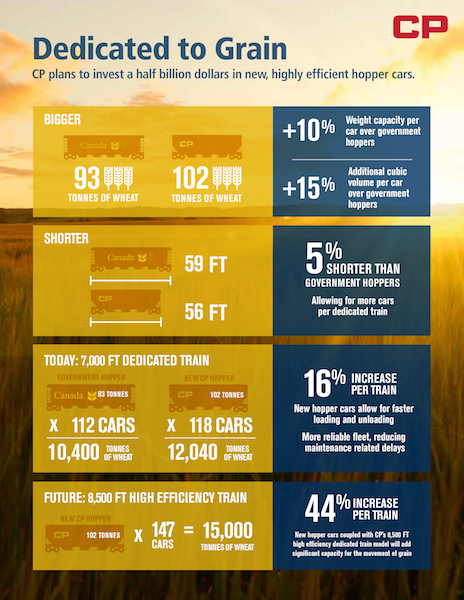
Check out the new cool video by CP:
Greater supply chain capacity and efficiency
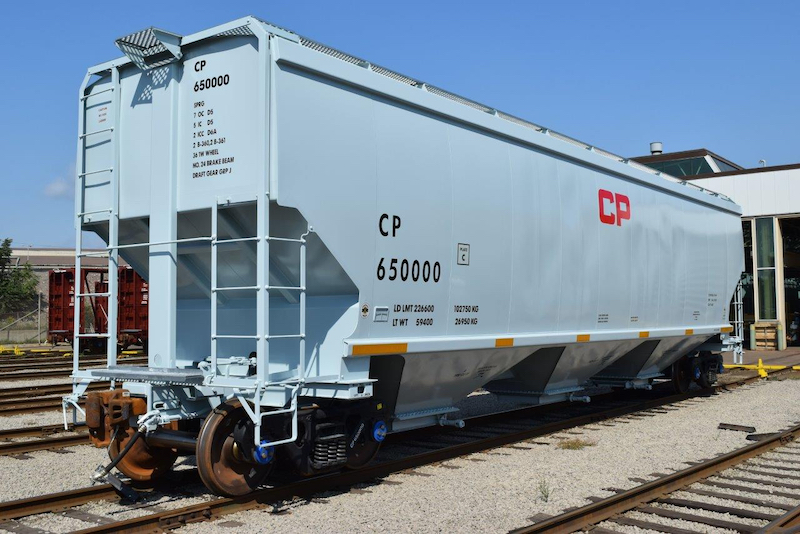
This completely new prototypically accurate model is scheduled to follow our other previously announced releases that are making their way through the design, production and delivery processes:
a) Modified 4300 cu ft Potash car K+S (shipping from our factory in 2 weeks)
b) 5077 PS Boxcar (shipping from our factory in the fall)
c) 5092 NSC Boxcars (revised test samples coming in August; shipping Winter 2019)
d) Marine Industries 4550 (tooling complete shipping Spring 2020)
“Grain Car Of The Future”
NARC has a long history of working with National Steel Car (NSC) in the research and development of our model railroad products. It was through this relationship two years ago that we learned about a car design that was poised to become “the grain car of the future”. At the time only two customers had placed orders for the car but thousands of new cars were expected to follow as replacements for the 40 to 50 year old 4550 cu ft Cylindrical Hoppers that were and are nearing the end of their useful lives. In a few years, the only place you will likely see one of these is in a museum. Just like the 40ft boxcars, their era is coming to an end.
The Canadian Government passed legislation last year to allow the railways to increase the tariff (rate charged to customers) for moving export grain from farm to port. The increased tariff was put in place to pay for the cost of acquiring the new fleet of cars.
The new cars can load 100 metric tons (tonnes) compared to old cars, which are limited to 90 tonnes. A tonne is about 10% heavier than a U.S. ton. The new cars are also shorter, allowing more cars per train (up from a typical length of 112 cars to at least 134 cars). These changes in efficiency will completely change the economics of the grain distribution and transportation in Western Canada.
You will also notice that the new car looks like a stretched version of our 4300 cu ft Potash Car. See illustration below.
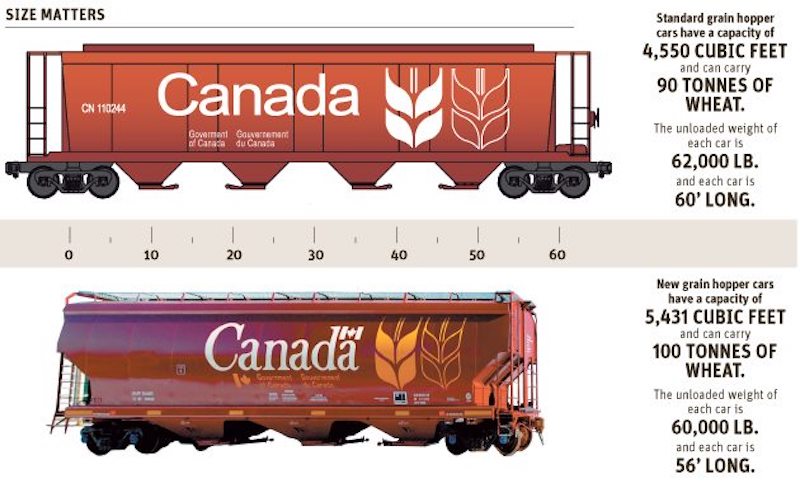
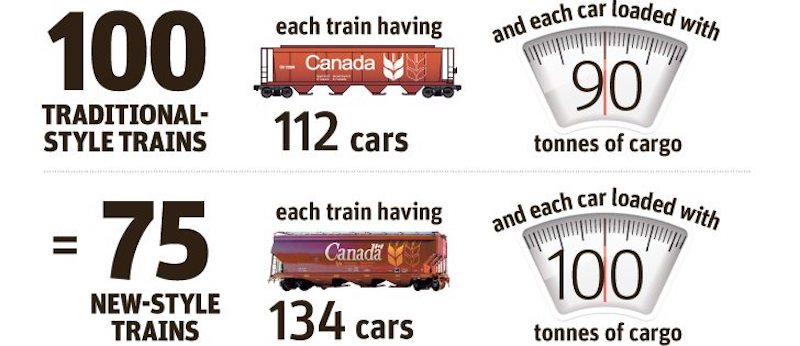
These new cars will be the catalyst for change throughout the industry. Over time the number of private grain cars will increase, each with their own reporting marks and/or logos. Elevators will become larger, more efficient, and fewer in number. Almost 3,000 elevators dotted the Prairies in the 1980s, compared to just under 350 today. More grain handling facilities will be large loop track systems that can load an entire 134 car unit train in under eight hours, helping to reduce the cycle time from farm to port and back by several days.
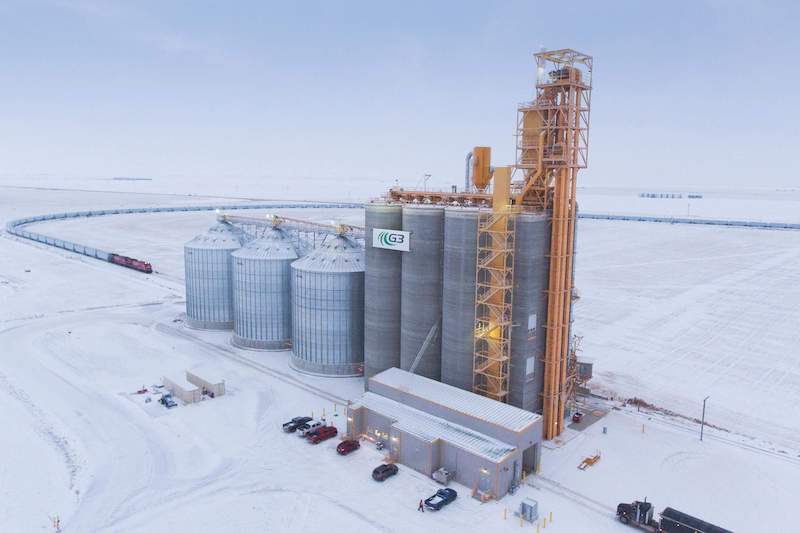
A CP grain train prepares to load grain at a recently constructed loop-style grain elevator with a solid consist of NSC 5431 covered hoppers.
photo courtesy; www.canadianpacificmagazine.ca
![]()
• Meticulously researched and designed
• 2 different roofs and photo-etched metal roof walks (11 or 16 supports)
• Photo-etched metal crossover platforms (with individually applied supports)
• 2 different end cage variations (Tapered or Angled corners)
• 3 Different Outlet Gates (Gravity, ATP Long Gravity, Miner Short)
• Investment castings for capstans (end of gates)
• 2 Different Hand Brakes (conventional and “High Power” Ellcon-National)
• 2 Different Reservoir Positions (low for truck mounted cylinders and high for body mounted cylinders)
• External brake rod on cars with body mounted brakes cylinders (including levers)
• 2 Different styles of trough hatches (squared or rounded)
• Kadee # 58 semi-scale couplers
• Coupler Cut Bars
• 2 Bolster/Jack Pad Styles (flat and sloped faces)
• North American Railcar High-Performance Low Friction Trucks Barber S-2 100 ton trucks with semiscale 36” wheels
• 2 different hopper bay variations (with or without vibrator brackets)
The car will come in 11 different paint schemes:
Canadian Pacific Red Lettering (CP) - 12 Road Numbers
Canadian Pacific Beaver Logo (CP) - 12 road numbers
Canadian National (CN) - 12 road numbers
Burlington Northern Santa Fe (BNSF) - 12 road numbers
Grains Connect Canada (CN / Wheat Board Partnership) (WFRX) - 12 road numbers
Louis Dreyfus Company NKLX - 12 road numbers
Parrish & Heimbecker PHLX - 12 road numbers
Richardson International (TRGX) Tapered Corner Version (End Ladders) - 12 road numbers
Richardson International (TRGX) Beveled Corner Version (End Ladders) - 12 road numbers
First Union Rail (FURX) - 12 road numbers
CAI Rail Inc (CAIX) - 6 road numbers

Canadian Pacific Red Lettering (CP) - 12 road numbers
Photo Courtesy National Steel Car
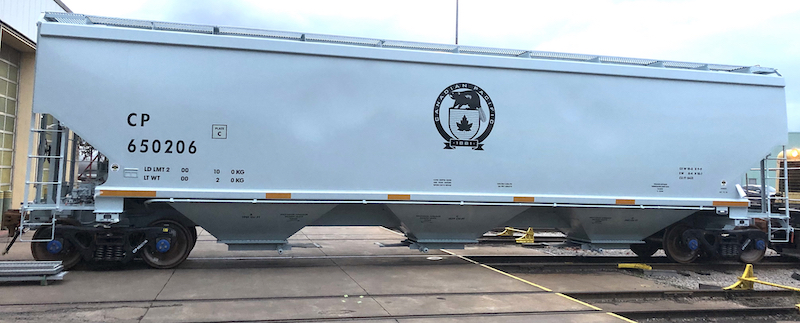
Canadian Pacific Beaver Logo (CP) - 12 road numbers
Photo Courtesy National Steel Car
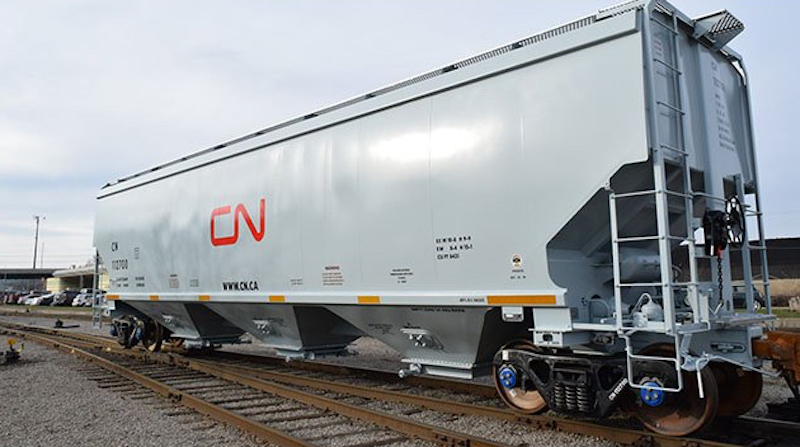
Canadian National (CN) - 12 road numbers
Photo Courtesy National Steel Car
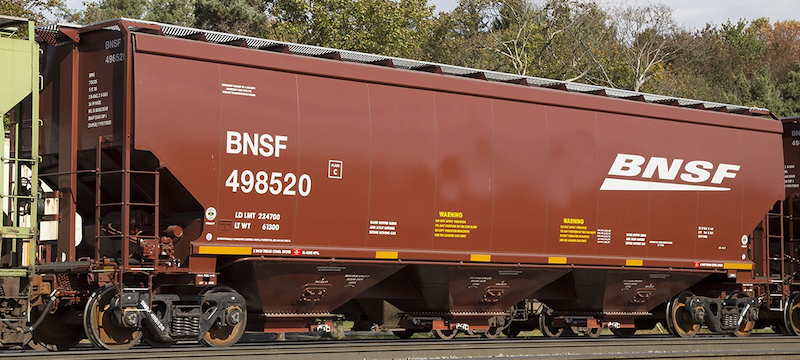
Burlington Northern Santa Fe (BNSF) - 12 road numbers
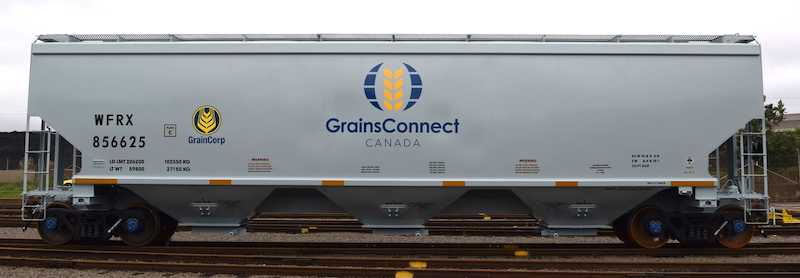
Grains Connect Canada (CN / Wheat Board Partnership) (WFRX) - 12 road numbers
Photo Courtesy National Steel Car

Louis Dreyfus Company NKLX - 12 road numbers
Photo Courtesy National Steel Car
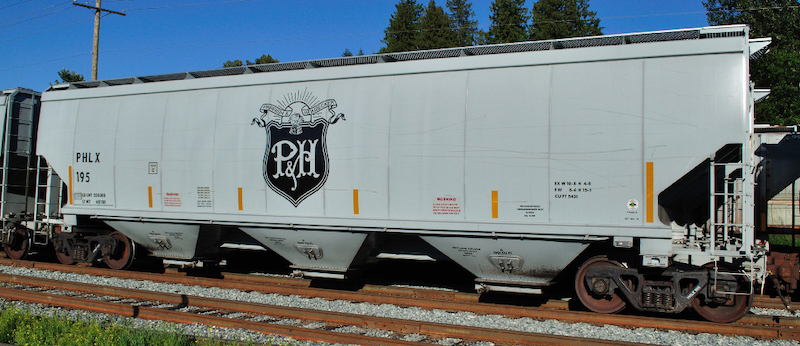
Parrish & Heimbecker PHLX - 12 road numbers
Photo Courtesy Michael MacGowan
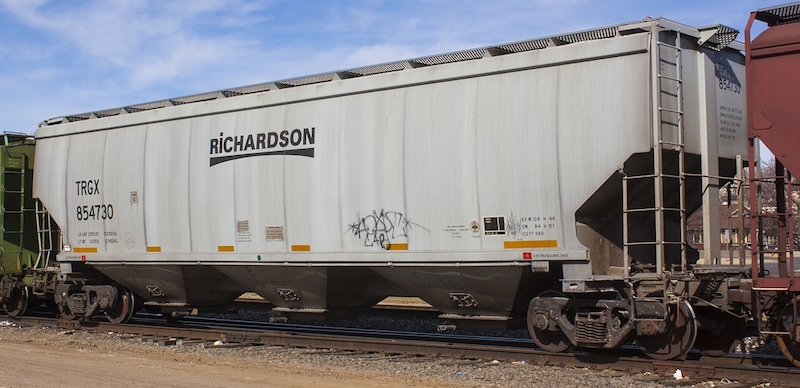
Richardson International (TRGX) Tapered Corner Version (End Ladders) - 12 road numbers
Photo by Luke Lohrmeyer
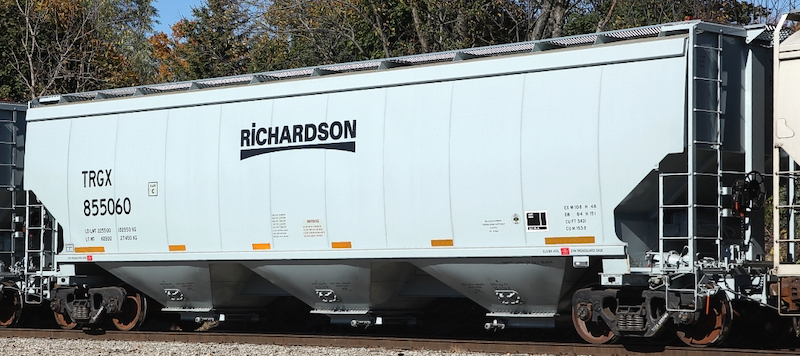
Richardson International (TRGX) Beveled Corner Version (End Ladders) - 12 road numbers
Photo by Mike Rujak
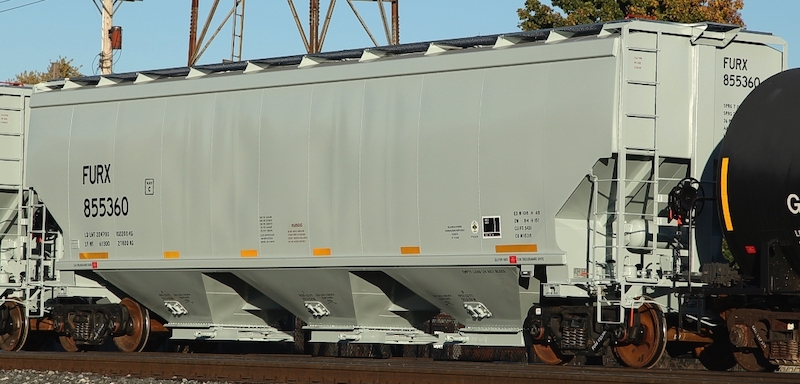
First Union Rail (FURX) - 12 road numbers
Photo by Mike Rujak
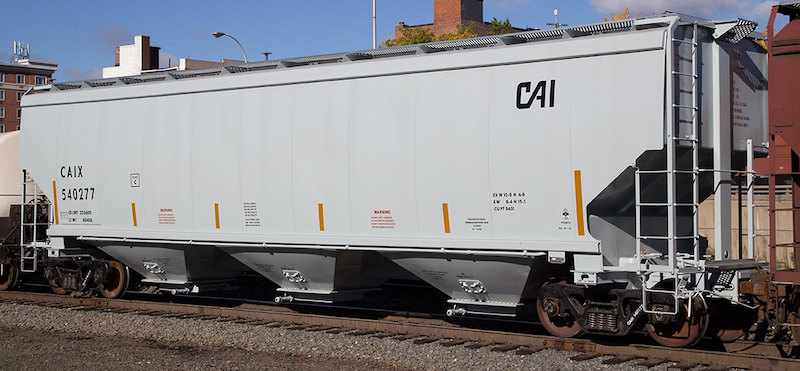
CAI Rail Inc (CAIX) - 6 road numbers




















